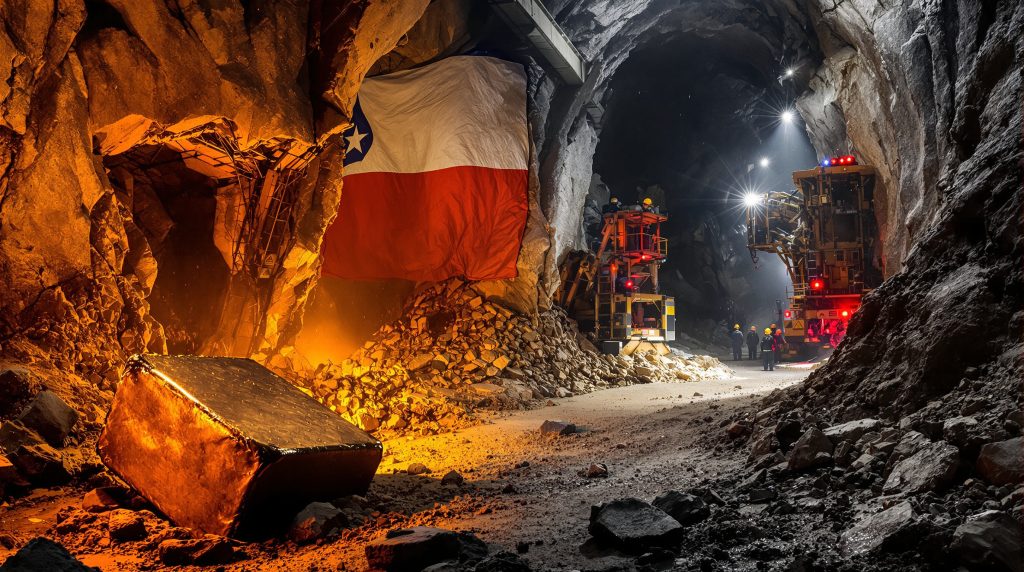The State of Codelco's Production Crisis
Codelco, Chile's state-owned mining giant, has experienced a dramatic decline in copper production, reaching a 20-year low in August 2025. Production plummeted to just 93,400 tonnes, representing a 25% decrease compared to the same month in 2024. This significant drop marks the lowest monthly output in more than two decades for the company once considered the world's premier copper producer.
The production crisis comes at a particularly challenging time for global copper supply forecast, with supply constraints intensifying just as demand accelerates from multiple sectors. The energy transition's growing need for copper in renewable infrastructure, combined with the expanding data center construction boom, has created a perfect storm of market pressure.
Industry analysts note that Codelco's struggles represent more than just a company-specific issue—they signal broader concerns about copper supply security at a critical juncture for global decarbonization efforts. The Chilean giant's ability to maintain production has become increasingly relevant to global industrial and energy policy planning.
According to Chilean copper agency Cochilco data, this production decline follows what had been modest recovery attempts earlier in 2025, making the sudden reversal particularly concerning for market watchers tracking global copper supply chains.
What Caused the El Teniente Mine Disaster?
The Catastrophic Accident
The primary trigger for the recent production collapse was a devastating accident at Codelco's El Teniente mine on July 31, 2025. This earthquake-induced disaster occurred in the Andesita section of the mine's extensive underground tunnel network, resulting in widespread damage and human tragedy.
The incident claimed six worker lives and left nine others injured, marking it as the worst mining accident in Chile in three decades. The catastrophe forced a complete operational shutdown for over a week while rescue and recovery operations were conducted in challenging underground conditions.
Infrastructure damage was extensive, with approximately 3,700 meters of tunnels severely compromised and four mining sectors rendered completely inaccessible. Engineers assessing the damage reported significant structural instability throughout connected tunnel systems, complicating recovery efforts.
The geological conditions that contributed to the disaster highlight the inherent risks of deep mining operations in seismically active regions like Chile's copper belt. Preliminary investigations suggest that a relatively moderate seismic event triggered disproportionate damage due to pre-existing structural weaknesses in older tunnel sections.
Impact on Output and Operations
The El Teniente disaster has had severe consequences for Codelco's production capabilities across multiple dimensions:
- An estimated 33,000 tonnes of copper production lost directly due to the accident
- Financial losses between $300-340 million from both immediate damage and ongoing production interruptions
- Prolonged recovery period required for affected areas, with some sections potentially requiring years of rehabilitation
- Continued safety concerns affecting operational decisions throughout the El Teniente complex
While operations have resumed in areas unaffected by the collapse, the damage to critical infrastructure continues to hamper production efforts. Mining engineers face substantial challenges in stabilizing remaining tunnel networks while simultaneously developing new access routes to bypass damaged sections.
The accident's timing proved particularly unfortunate, as it disrupted what had been a modest production recovery for Codelco in the first half of 2025. Company data showed that June 2025 had delivered a promising 17% year-over-year increase before the disaster reversed this positive trend.
How Does This Fit Into Codelco's Longer-Term Decline?
Historical Production Trajectory
The recent disaster accelerates what has been a concerning multi-year downward trend for Codelco. The company's production challenges reflect both acute operational issues and more fundamental structural problems that have evolved over decades.
| Year | Production Trend | Contributing Factors |
|---|---|---|
| 2004 | Peak production period | Favorable ore grades, optimal operational conditions |
| 2023 | Declined to 72% of 2004 levels | Aging infrastructure, declining ore grades |
| Early 2025 | Brief recovery (17% YoY increase in June) | Operational improvements, investment in technology |
| August 2025 | 20-year production low | El Teniente disaster, ongoing structural challenges |
This long-term pattern reveals how Codelco's production has steadily eroded from its historical heights despite periodic recovery attempts. The company that once dominated global copper production now struggles to maintain its position among the industry's top tier producers.
Mining industry veterans point to this trajectory as emblematic of the challenges facing mature copper operations globally. The natural lifecycle of mines often includes a gradual decline phase as the most accessible, high-grade ore bodies become depleted and operations must contend with increasingly complex geological conditions.
For context, Chilean copper production overall has shown greater resilience than Codelco's output alone, indicating that the company's challenges reflect specific operational and management issues beyond the general aging of Chile's copper resources.
What Are the Operational Challenges Facing Codelco?
Aging Infrastructure and Technical Difficulties
Codelco operates some of the world's oldest and most complex copper mining operations, creating unique challenges that newer mining developments can avoid:
- Deteriorating underground infrastructure requiring constant maintenance and rehabilitation
- Increasing depths of mining operations, raising costs and technical complexity exponentially
- Water management issues in older mine sections, particularly with deepening operations
- Need for substantial capital investment to maintain production levels amid declining conditions
The El Teniente mine itself, operational since 1905, represents one of the oldest continuously operating underground mines globally. Its extensive network of tunnels spans hundreds of kilometers, creating immense engineering challenges for maintenance and expansion.
Technical difficulties extend beyond physical infrastructure to include ventilation challenges, ground control issues, and increasingly complex logistics as operations extend farther from primary access points. Each of these factors compounds the others, creating a negative feedback loop of operational complexity.
Resource Quality Issues
The quality of accessible copper resources has been declining steadily across Codelco's operations:
- Lower ore grades requiring more material to be processed for the same copper yield
- More complex mineralogy increasing processing costs and reducing recovery rates
- Greater depths requiring more energy and infrastructure investment per tonne produced
- Increased waste rock management challenges and associated environmental considerations
Industry analysis indicates that average ore grades across Codelco's operations have declined by approximately 30% since 2000, forcing the company to process substantially more material for diminishing returns. This fundamental challenge requires both technological innovation and strategic rethinking of mining approaches.
Geological limitations increasingly constrain Codelco's options, as the natural endowment of Chile's copper belt transitions from the exceptionally rich deposits that established the country's mining prominence to more challenging resources that test the economic viability of extraction.
How Does This Impact the Global Copper Market?
Supply Implications
Codelco's production problems create significant ripple effects across global copper markets with both immediate and long-term consequences:
- Tightening global supply at a time of increasing demand from multiple growth sectors
- Potential price volatility as markets adjust to reduced output from a historically reliable producer
- Greater reliance on other major producers like BHP's Escondida mine to fill supply gaps
- Increased focus on new project development globally to address projected supply deficits
Market analysts note that global copper inventories remain near historic lows, leaving little buffer against production disruptions. London Metal Exchange (LME) warehouse stocks have struggled to build meaningful reserves, making the market particularly sensitive to production news.
The timing of Codelco's challenges coincides with accelerating demand from electric vehicle manufacturing, renewable energy infrastructure, and data center construction—all copper-intensive applications with strong growth trajectories.
Competitive Landscape Shifts
The production decline has altered the competitive dynamics in the copper mining sector, redistributing market influence among major producers:
| Producer | August 2025 Production | Year-over-Year Change | Market Position |
|---|---|---|---|
| Codelco | 93,400 tonnes | -25% | Losing market share |
| Escondida (BHP) | 105,100 tonnes | Minimal change | Maintaining position as world's largest copper mine |
| Collahuasi (Anglo American/Glencore) | Slight increase from July | Below 2024 levels | Dealing with lower-quality ore challenges |
These shifts highlight how operational challenges at one major producer can reshape the entire industry landscape. BHP's Escondida operation in Chile has cemented its position as the world's single largest copper producing mine, benefiting from more modern infrastructure and relatively higher-grade resources.
The changing competitive dynamics have also accelerated investment interest in copper projects outside traditional production centers like Chile and Peru, with increasing attention to frontier regions with undeveloped resources. Companies with diversified global portfolios appear better positioned to navigate the evolving market conditions than those concentrated in single regions.
What Recovery Efforts Are Underway?
Immediate Response Measures
Following the El Teniente disaster, Codelco implemented several emergency measures aimed at stabilizing operations and minimizing production losses:
- Comprehensive safety reviews across all mining operations to prevent similar incidents
- Structural reinforcement of vulnerable tunnel sections identified through enhanced monitoring
- Reallocation of resources to unaffected mining areas to maintain partial production capability
- Revised production planning to maximize output from safe zones while recovery continues
Safety has become the paramount concern, with company officials acknowledging that production targets must be secondary to ensuring worker wellbeing. This represents a significant shift in operational priorities that may persist long after the immediate crisis response.
Engineers have developed alternative mining sequences to access unaffected ore bodies while avoiding compromised areas, though these workarounds typically involve less efficient extraction methodologies that further impact production volumes.
Long-Term Strategic Adjustments
Beyond addressing the immediate crisis, Codelco is pursuing several strategic initiatives to fundamentally transform its operations for future sustainability:
- Accelerated investment in automation and remote mining technologies to reduce worker exposure
- Exploration of new mining areas with potentially higher grades to offset declining resources
- Reassessment of capital expenditure priorities to focus on production recovery and stabilization
- Enhanced safety protocols and structural monitoring systems using advanced sensing technologies
The company has also intensified its focus on technological innovation, including partnerships with equipment manufacturers and mining technology developers to implement next-generation solutions for aging operations.
Industry experts suggest these strategic adjustments represent an overdue recognition that Codelco's traditional operating model requires fundamental reimagination rather than incremental improvement. The crisis has created both necessity and opportunity for transformative change.
What Does This Mean for Copper's Future?
Market Outlook
The production challenges at Codelco come at a critical time for global copper markets, with multiple demand drivers converging:
- Growing demand from renewable energy infrastructure development, with each gigawatt of solar and wind capacity requiring substantial copper inputs
- Expanding requirements from data center construction, which has accelerated dramatically with AI computing growth
- Increasing electrification across transportation and industrial sectors driving consistent demand growth
- Limited new major copper projects coming online globally due to extended development timelines
These factors suggest continued market tightness and potential upward copper price insights if production issues persist. Industry analysts project a potential copper supply deficit approaching 8 million tonnes annually by 2032 without significant new project development.
The supply constraints come as copper's strategic importance increases, with the metal playing a crucial role in virtually all decarbonization technologies. This combination of limited supply and expanding essential applications has elevated copper to "critical mineral" status in many jurisdictions.
Strategic Importance
Codelco's struggles highlight broader concerns about copper supply security that extend beyond market dynamics to geopolitical considerations:
- Chile's continued role as the world's leading copper producer despite production challenges
- The difficulties of maintaining production from aging mining assets globally, not just in Chile
- The need for significant investment in new copper projects worldwide to meet projected demand
- The strategic importance of copper for energy transition challenges and digital infrastructure
These factors have elevated copper supply from a purely commercial concern to a matter of industrial policy and national security for many nations. The material's essential role in clean energy technologies has made secure access to copper a priority for countries pursuing decarbonization targets.
Industry stakeholders increasingly recognize that copper supply constraints could potentially limit the pace of global energy transition efforts if not addressed through coordinated development strategies. This realization has stimulated renewed interest in both production expansion and recycling initiatives.
Can Codelco Reverse Its Production Decline?
Codelco faces a pivotal moment in its storied history. The combination of the El Teniente disaster and longer-term structural challenges has created unprecedented pressure on the company's production capabilities and organizational resilience.
While recovery efforts are underway, reversing the decline will require substantial investment, technical innovation, and strategic vision. The company must simultaneously address immediate safety and production concerns while implementing fundamental operational transformations to ensure long-term viability.
Success will likely depend on several critical factors:
- The effectiveness of infrastructure rehabilitation efforts at El Teniente
- The company's ability to accelerate technological modernization across aging operations
- Success in developing new mining areas with more favorable geological conditions
- Securing adequate capital investment despite financial pressures from reduced production
The company's ability to overcome these challenges will have significant implications not only for Chile's economy but for global copper markets and the broader energy transition. As copper demand continues to grow from multiple sectors, the industry will be watching closely to see if Codelco can regain its position as a premier copper producer.
Disclaimer: The outlook and analysis presented regarding Codelco's future production capabilities involve significant uncertainty. Actual recovery timelines, production levels, and market impacts may differ substantially from these projections based on numerous factors including geological conditions, technical developments, market dynamics, and policy decisions.
FAQs About Codelco's Copper Production Decline
What is Codelco's current annual production target after the El Teniente accident?
Codelco has been forced to revise its annual production targets downward by approximately 33,000 tonnes following the El Teniente accident, representing a significant adjustment to its yearly output projections. This reduction impacts the company's revenue forecasts and capital expenditure planning for upcoming quarters.
How does Codelco's production compare to other major copper producers?
While historically the world's largest copper producer, Codelco now produces less than BHP's Escondida mine, which delivered 105,100 tonnes in August 2025 compared to Codelco's 93,400 tonnes. This shift reflects both Codelco's operational challenges and the successful expansion of competing operations globally.
What percentage of global copper supply does Codelco represent?
Codelco typically accounts for approximately 8-10% of global copper production, making its output fluctuations significant for worldwide supply balances. This substantial market share means that Codelco's production challenges have outsized effects on global copper availability and pricing.
How long might recovery take at the El Teniente mine?
Complete recovery at El Teniente will likely take many months, with some sections potentially requiring years of rehabilitation work before returning to full production capacity. The extensive tunnel damage presents complex engineering challenges that cannot be resolved quickly, even with substantial resource allocation.
What are the environmental implications of Codelco's production challenges?
Production disruptions can sometimes lead to environmental compliance challenges as operations are modified to maintain output, potentially affecting water usage, waste management, and energy consumption patterns. However, reduced production volumes may temporarily decrease certain environmental impacts while creating pressure to maximize output from remaining operational areas. Additionally, the company may need to implement new mine reclamation strategies in severely damaged areas that cannot be economically restored for production.
Furthermore, as the mining industry faces growing scrutiny, Codelco will need to balance recovery efforts with advancing industry innovation trends in sustainability practices despite financial constraints from its Codelco copper production decline.
Ready to Spot the Next Major Copper Discovery?
Discovery Alert's proprietary Discovery IQ model delivers instant notifications when significant ASX copper discoveries are announced, helping investors position themselves ahead of the market. Visit our discoveries page to understand how historic mineral discoveries have generated substantial returns for early investors.




